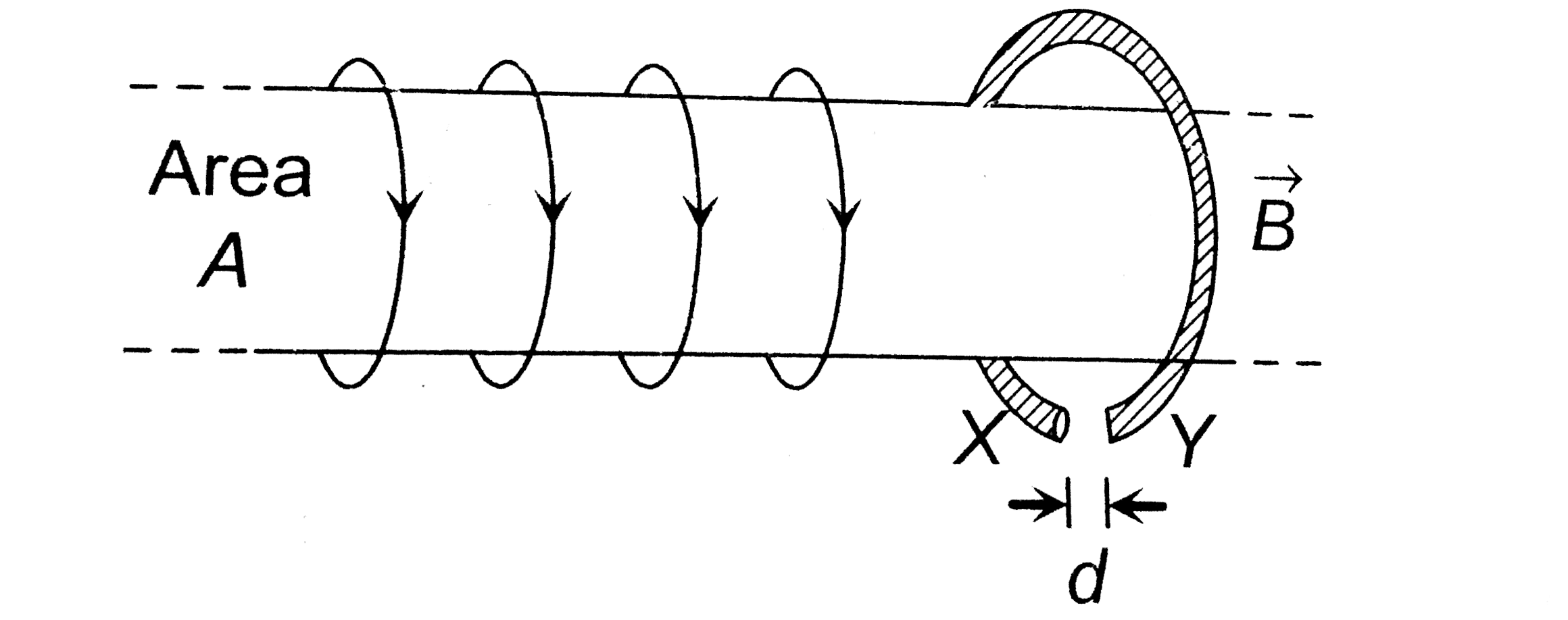A highly conducting ring of radius R is perpendicular to and concentric with the axis of a long solenoid as shown in Fig. 3.182. The ring has a narrow gap of width δ in its circumference. The cross-sectional area of the solenoid is a. The solenoid has a unifoem unitial field of magnitude B(t)=B0+βt, where β>0. Assuming that no charge can flow across the gap, the face (s) accumulating an excess of positive charge is /are

(a) F1
(b) F2
( c) F1andF2 both
(d) difficult to conclude as data given are insufficient
The correct Answer is:A, D
(a,d): Apply Lenz's law
Topper's Solved these Questions
- ELECTROMAGNETIC INDUCTIONBOOK - CENGAGE PHYSICSCHAPTER - ELECTROMAGNETIC INDUCTIONEXERCISE - Exercises Asserton - Reasoning
8 Videos
- ELECTROMAGNETIC INDUCTIONBOOK - CENGAGE PHYSICSCHAPTER - ELECTROMAGNETIC INDUCTIONEXERCISE - Exercises Linked Comprehension
36 Videos
- ELECTROMAGNETIC INDUCTIONBOOK - CENGAGE PHYSICSCHAPTER - ELECTROMAGNETIC INDUCTIONEXERCISE - Exercises Single Correct
79 Videos
- ELECTROMAGENTIC INDUCTIONBOOK - CENGAGE PHYSICSCHAPTER - ELECTROMAGENTIC INDUCTIONEXERCISE - QUESTION BANK
40 Videos
- ELECTRON,PHONTS,PHOTOELECTRIC EFFECT & X-RAYSBOOK - CENGAGE PHYSICSCHAPTER - ELECTRON,PHONTS,PHOTOELECTRIC EFFECT & X-RAYSEXERCISE - dpp 3.3
15 Videos
Similar Questions
A very long straight solenoid carries a current i. The cross-sectional area of the solenoid is equal to S, the number of turns per unit length is equal to n. Find the flux of the vector B through the end plane of the solenoid.
View SolutionA conducting ring is placed near a solenoid as shown in Fig.3.21. Find the direction of the induced current in the ring.
(a) At the instant the switch in the circuit containing the solenoid is closed.
(b) After the switch has been closed for a long time.
(c) At the instant the switch is opened.

View Solution
Knowledge Check
A highly conucting ring of radius R is perpendicular to and concentric with the axis of a long solenoid as shown in fig. the ring has a narrow gap of width d in its circumference. The solenoid has cross sectional area A and a uniform internal field of magnitude B0. Now beginning at t=0, the solenoid current is steadily increased to so that the field magnitude at any time t is given by B(t)=B0+αt where α>0. Assuming that no charge can flow across the gap, the end of ring which has excess of positive charge and the magnitude of induced e.m.f. in the ring are respectively
 Ax,AαBXπR2aCY,pA2αDY,πR2a
Ax,AαBXπR2aCY,pA2αDY,πR2aMagnetic field B along the axis of a long solenoid is given by
A B
B C
C D
D
The ring B is coaxial with a solenoid A as shown in figure. As the switch S is closed at t=0, the ring B
 Ais attracted towards ASBis repelled by ACis initially repelled and then attractedDis initially attracted and then repelled
Ais attracted towards ASBis repelled by ACis initially repelled and then attractedDis initially attracted and then repelled
Consider a metal ring kept on top of a fixed solenoid (say on a cardboard) as shown in Fig. 6.28. The centre of the ring coincides with the axis of the solenoid. If the current is suddenly switched on, the metal ring jumps up. Explain.

View SolutionA long solenoid of N turns has a self-induced L and area of cross-section A. When a current i flows through the solenoid, magnetic field inside it has magnitude B . The current i is equal to
View SolutionA conducting ring of radius b is placed coaxially in a long solenoid of radius a (b < a) having n turns per unit length. A current i=i0, cosωt flows through the solenoid. The induced emf in the ring is
View SolutionA long solenoid has 800 turns per metre length of solenoid A current of 1.6 A flow through it. The magnetic induction at the end of the solenoid on its axis is
View SolutionA long solenoid has 800 turns per metre length of solenoid. A current of 1.6 A flows through it. The magnetic induction at the end of the solenoid on its axis is
View Solution
